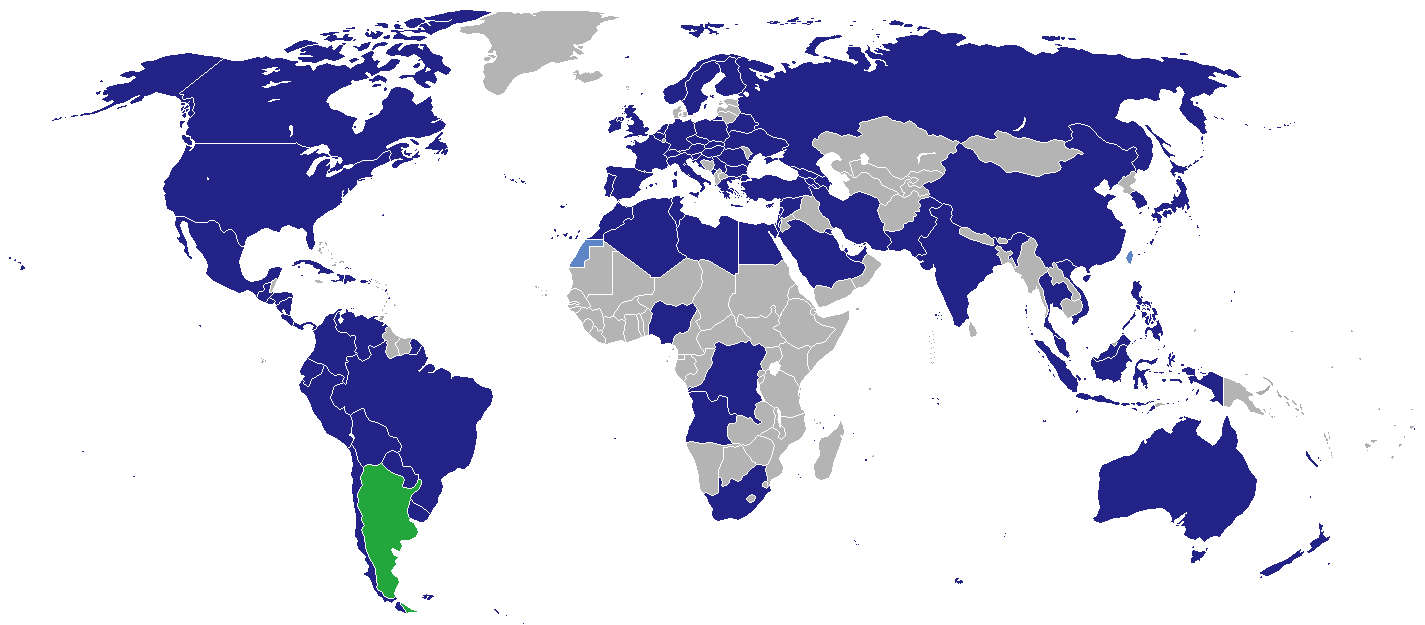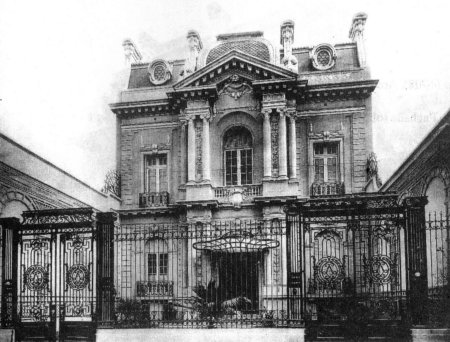|
Argentine Foreign Ministry
The Ministry of Foreign Affairs, International Trade and Worship ( es, Ministerio de Relaciones Exteriores, Comercio Internacional y Culto; MRECIC), informally referred to as the Chancellery ( es, Cancillería), is the Argentine government ministry dealing with the foreign relations of Argentina, Argentina's foreign policy, international development, international trade, diaspora and matters dealing with Mercosur and the Catholic Church. The Ministry of Foreign Affairs is one of the oldest continuously existing portfolios in the Argentine government, having existed uninterruptedly since the formation of the first Argentine executive in 1854, in the presidency of Justo José de Urquiza. The incumbent minister is Santiago Cafiero, who has served since 20 September 2021 in the cabinet of Alberto Fernández. Structure and dependencies The Ministry's Department of Worship (''Secretaría de Culto'') has several directorates. The Registry Directorate maintains the National Register o ... [...More Info...] [...Related Items...] OR: [Wikipedia] [Google] [Baidu] |
San Martín Palace
San Martín Palace (''Palacio San Martín'') is located facing Plaza San Martín in the Retiro neighbourhood of Buenos Aires, Argentina and serves as the Ceremonial Headquarters for the Ministry of Foreign Relations. History The Beaux Arts style palace was designed for Mercedes Castellanos de Anchorena by the architect Alejandro Christophersen in 1905. Finished in 1909, the building was acquired by the Argentine government in 1936 and became the headquarters for the Ministry of Foreign Relations. A new headquarters was completed in 1993, and at present the palace serves as the Ceremonial Headquarters for the Ministry. The palace contains many works of art by Argentine and American artists from the 20th century, including Antonio Berni, Pablo Curatella Manes, Lino Enea Spilimbergo, and Roberto Matta Roberto Sebastián Antonio Matta Echaurren (; November 11, 1911 – November 23, 2002), better known as Roberto Matta, was one of Chile's best-known painters and a semi ... [...More Info...] [...Related Items...] OR: [Wikipedia] [Google] [Baidu] |
Retiro, Buenos Aires
Retiro is a ''barrio'' or neighborhood in Buenos Aires, Argentina. Located in the northeast end of the city, Retiro is bordered on the south by the Puerto Madero and San Nicolás, and on the west by the Recoleta. History Towards the end of the 17th century and the beginning of the 18th was installed in the area, an asiento of slaves belonging to the Compagnie de Guinée and South Sea Company, that operated until 1739. In 1800 began the construction of Plaza de Toros del Retiro, a stadium of bullfighting built by the architect Francisco Cañete, that worked until 1819. In the Plaza de Toros took place the battles between the troops of Santiago de Liniers and the British army, occurred during the English invasions of 1806 and 1807. In 1821 was installed the first dissident cemetery of Buenos Aires, located in the vicinity of Iglesia Nuestra Señora del Socorro. This cemetery was place were buried the people who professed the Protestant religion, mostly English. The dissident ... [...More Info...] [...Related Items...] OR: [Wikipedia] [Google] [Baidu] |
Religious Affairs Ministries
Religion is usually defined as a social system, social-cultural system of designated religious behaviour, behaviors and practices, morality, morals, beliefs, worldviews, religious text, texts, sacred site, sanctified places, prophecy, prophecies, ethics in religion, ethics, or religious organization, organizations, that generally relates humanity to supernatural, transcendence (religion), transcendental, and spirituality, spiritual elements; however, there is no scholarly consensus over what precisely constitutes a religion. Different religions may or may not contain various elements ranging from the Divinity, divine, Sacred, sacred things, faith,Tillich, P. (1957) ''Dynamics of faith''. Harper Perennial; (p. 1). a supernatural being or supernatural beings or "some sort of ultimacy and transcendence that will provide norms and power for the rest of life". Religious practices may include rituals, sermons, commemoration or veneration (of deities or saints), sacrifices, festivals, ... [...More Info...] [...Related Items...] OR: [Wikipedia] [Google] [Baidu] |
Foreign Affairs Ministries
A foreign affairs minister or minister of foreign affairs (less commonly minister for foreign affairs) is generally a cabinet minister in charge of a state's foreign policy and relations. The formal title of the top official varies between countries. The foreign minister typically reports to the head of government (such as prime minister or president). Difference in titles In some nations, such as India, the foreign minister is referred to as the minister for external affairs; or others, such as Brazil and the states created from the former Soviet Union, call the position the minister of external relations. In the United States, the secretary of state is the member of the Cabinet who handles foreign relations. Other common titles may include minister of foreign relations. In many countries of Latin America, the foreign minister is colloquially called " chancellor" (''canciller'' in the Spanish-speaking countries and ''chanceler'' in the Portuguese-speaking Brazil). Diploma ... [...More Info...] [...Related Items...] OR: [Wikipedia] [Google] [Baidu] |
Government Ministries Of Argentina
A government is the system or group of people governing an organized community, generally a state. In the case of its broad associative definition, government normally consists of legislature, executive, and judiciary. Government is a means by which organizational policies are enforced, as well as a mechanism for determining policy. In many countries, the government has a kind of constitution, a statement of its governing principles and philosophy. While all types of organizations have governance, the term ''government'' is often used more specifically to refer to the approximately 200 independent national governments and subsidiary organizations. The major types of political systems in the modern era are democracies, monarchies, and authoritarian and totalitarian regimes. Historically prevalent forms of government include monarchy, aristocracy, timocracy, oligarchy, democracy, theocracy, and tyranny. These forms are not always mutually exclusive, and mixed governme ... [...More Info...] [...Related Items...] OR: [Wikipedia] [Google] [Baidu] |
List Of Diplomatic Missions In Argentina
This is a list of diplomatic missions in Argentina. There are currently 84 embassies in Buenos Aires, and many countries maintain consulates in other Argentine cities (not including honorary consulates). Diplomatic missions in Buenos Aires Embassies * * * * * * * * * * * * * * * * * * * * * * * * * * * * * * * * * * * * * * * * * * * * * * * * * * * * * * * * * * * * * * * * * * * * * * * * * * * * * * * * * * * * * Other missions or delegations * ( Economic & Cultural Office) * (Delegation) * (Delegation) Gallery of embassies File:Australian Embassy, Buenos Aires, Arg 03.jpg, Embassy of Australia File:Bolivian Embassy, Buenos Aires 02.jpg, Embassy of Bolivia File:Embajada de Brasil en Buenos Aires.jpg, Embassy of Brazil File:Bulgarian Embassy, Buenos Aires 01.jpg, Embassy of Bulgaria File:Canadian Embassy, Buenos Aires.jpg, Embassy of Canada File:Chilean Embassy, Buenos Aires 02.jpg, Embassy of Chile File:EmbajadaDeColombiaEnArgentina.jpg, Embassy of Colombia File ... [...More Info...] [...Related Items...] OR: [Wikipedia] [Google] [Baidu] |
List Of Diplomatic Missions Of Argentina
Argentina has the 14th most diplomatic missions of any country in the world, including 85 of the 193 members states of the United Nations (UN), as well as observer states Palestine and Vatican City and non-member country of Taiwan. This list excludes honorary consulates. Current missions Africa Americas Asia Europe Oceania Multilateral organizations Gallery File:Embassy of Argentina in Athens, Greece.jpg, Embassy in Athens File:Embassy of Argentina in Beijing, China.JPG, Embassy in Beijing File:Berlin - Botschaft von Argentinien 20191025.jpg, Embassy in Berlin File:Embassy residence of Argentina. - Budapest 12th district, Széchenyi Memorial Way.JPG, Residence of the Embassy in Bern File:Embajada de Argentina en Bogota.jpg, Embassy in Bogotá File:Embajada en Brasilia (5984985412).jpg, Embassy in Brasília File:Republica Argentina Embajada, 2020 Terézváros.jpg, Embassy in Budapest File:Embassy of Argentina in Canberra.jpg, Embassy in Canberra File:Den Haag - J ... [...More Info...] [...Related Items...] OR: [Wikipedia] [Google] [Baidu] |
Foreign Relations Of Argentina
This article deals with the diplomatic affairs, foreign policy and international relations of Argentina. At the political level, these matters are handled by the Ministry of Foreign Affairs, also known as the ''Cancillería'', which answers to the President. The current Minister of Foreign Affairs, since September 2021, is Chancellor (es: ''Canciller'') Santiago Cafiero. History From isolation to nationhood Owing to its geographical remoteness, local authorities in what is today Argentina developed an early sense of autonomy. Based largely on economic needs, during colonial times their pragmatism led to a flourishing unofficial market in smuggled goods, out of the then-small port of Buenos Aires, in blatant contravention of the Spanish mercantilist laws. With the Enlightened despotism of the late-eighteenth-century Bourbon kings and the creation of the Viceroyalty of the Río de la Plata in 1776, trade increased as the political importance of the port-city of Buenos ... [...More Info...] [...Related Items...] OR: [Wikipedia] [Google] [Baidu] |
La Nación
''La Nación'' () is an Argentine daily newspaper. As the country's leading conservative newspaper, ''La Nación''s main competitor is the more liberal '' Clarín''. It is regarded as a newspaper of record for Argentina. Its motto is: "''La Nación'' will be a tribune of doctrine." It is the second most read newspaper in print, behind ''Clarín'', and the third in digital format, behind '' Infobae'' and ''Clarín''. In addition, it has an application for Android and iOS phones. The newspaper's printing plant is in the City of Buenos Aires and its newsroom is in Vicente López, Province of Buenos Aires. The newsroom also acts as a studio for the newspaper's TV channel, LN+. Overview The paper was founded on 4 January 1870 (replacing the former publication ''Nación Argentina''), by former Argentine President Bartolomé Mitre and associates. Until 1914, the managing editor was José Luis Murature, Foreign Minister of Argentina from 1914-1916. Enjoying Latin America's larg ... [...More Info...] [...Related Items...] OR: [Wikipedia] [Google] [Baidu] |
Alejandro Christophersen
Alejandro Christophersen (1866–1946) was an Argentine architect and artist of Norwegian descent who designed many important buildings in the city of Buenos Aires, including the renowned Anchorena Palace. Biography Christophersen was born in Cádiz, Spain in 1866, the son of the Norwegian diplomat Otto Thorvald Alexander Christophersen, Consul to Spain. He studied architecture in Belgium and art in Paris. In 1888 he arrived in Argentina, and settled in Buenos Aires, during his career as an architect he gave the port city many of its most important buildings. He was a professor at the School of Architecture of the Faculty of Natural and Exact Sciences at the University of Buenos Aires, he is considered to be one of the central figures of eclectic architecture in Argentina, where he was one of the founder members of the Central Society of Architects. His earlier works were influenced by French Second Empire architecture, though his later projects were Rationalist. Chris ... [...More Info...] [...Related Items...] OR: [Wikipedia] [Google] [Baidu] |
Neighbourhoods Of Buenos Aires
Buenos Aires, autonomous city and capital of Argentina, is composed of forty-eight neighborhoods (locally known as ''barrios''). Since 2008, the city is also legally divided into communes, each one including one or more ''barrios''. Among the most visited and populated ''barrios'' are Palermo, Recoleta, Puerto Madero, Belgrano, San Telmo, La Boca, Monserrat and Caballito. Sectors of the city are also traditionally known as neighborhoods by the inhabitants of Buenos Aires, but not officially by the authorities of the city; some examples include Chinatown, Barrio Norte and the Microcentro. List of neighborhoods In alphabetical order, with the corresponding population and the commune they are grouped in. Informal neighborhood names The name Barrio Norte refers to the area around Avenida Santa Fe, encompassing parts of Retiro, Recoleta, and Palermo. The name ''Barrio Sur'' was used in the past to encompass the southern neighborhoods. This name has mostly fallen out of use, b ... [...More Info...] [...Related Items...] OR: [Wikipedia] [Google] [Baidu] |
.jpg)

.jpg)


